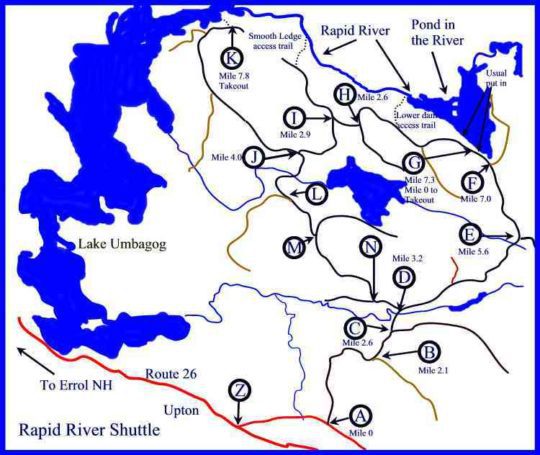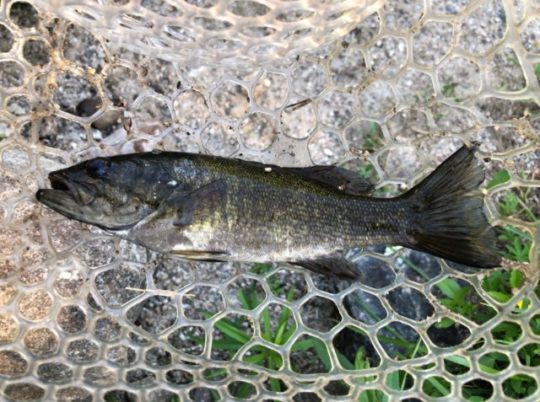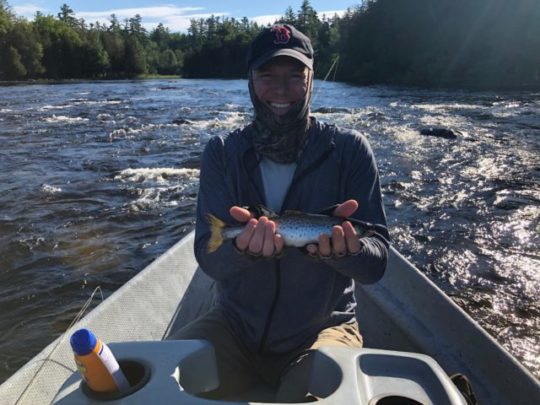Many things haven’t changed since 1941!
Read Part 2 of A Rapid River Primer here
March 27, 2025 update – I’ve done my best to make sure that all links are still up to date. If you’re looking to fish in Northern NH or Western Maine, Tom Freedman with Top Notch Fly Fishing is as good as it gets for guiding services. I also vouch for Tom’s friend Kris Thompson from Pond in the River Guide Service. The closest fly shop is the Rangeley Region Sports Shop. The easiest way to experience the river is to stay at Lakewood Camps.
INTRODUCTION
Located in The Great North Woods of Western Maine, the Rapid River is the premier brook trout fishery in the United States. It is a choice destination for landing a trophy-size wild brook trout (17 inches or longer) in its native range in the Lower 48.

A 2019 book, Squaretail: The Definitive Guide to Brook Trout and Where to Find Them by Bob Mallard, highlights it as the one of the last bastions where you have a good chance to land “the big one.”
Rapid River is hard to access, though this additional challenge may contribute to its appeal. If this discourages you, the nearby Lower Magalloway River below the Aziscohos Dam offers parking and tailwater water temperatures. It also has a population of big brook trout and is the next-best wild/native brook trout river.
However, the Rapid River is in a league of its own when it comes to huge fish and also has a biomass of landlocked Atlantic salmon, a fantastic gamefish in their own right.
If you’ve never fished inland Maine, it’s never too late! For the fly fisher on the East Coast, Maine is a much shorter and more economical trip than the trout meccas of the Rocky Mountains. Get a license and go for it!
In addition to Rapid and the Magalloway, the Kennebago River and many lakes in the Western Maine and Rangeley region are enough to make any fly fisher drool, especially those obsessed with native salmonids.
REGULATIONS
Only fly fishing is allowed on many bodies of water in Western Maine. If you don’t get a chance to visit Rapid River, seek out other FFO waters in the region, which are referenced in the Maine Department of Inland Fisheries and Wildlife Maine Fishing Laws. The aforementioned locations, including others with limited access such as Parmachenee Lake and Kennebago Pond, are largely FFO and catch-and-release. You will be in good company!
Rapid River itself is a barbless FFO zone and has a three-bag limit on salmon at least 12 inches long. Additionally, “All brook trout caught must be released alive at once.” This should give you an idea of the superlative qualities of this fishery.
South Richardson Lake, the source for the Rapid River, is stocked and has less restrictive regulations. Lastly, fishing three flies at the same time is allowed in the state of Maine, but lead split shot is not.

ACCESS
Admittedly, the Rapid River is exceptionally difficult to access for the day tripper. Motorized boat owners can make the 4 mile trip from the public boat launch at the South Arm of Lower Richardson.
Otherwise, your best option is staying at Lakewood Camps, a historic Maine camp on the lake a few minutes away from Middle Dam, where the Rapid River begins. Your stay at Lakewood includes a complementary boat shuttle from their private dock at the South Arm, which has a good road leading up to it.
WARNING
Carefully consider whom you invite for a stay at one of Western Maine’s sporting camps. Even passionate anglers on a slow day may be less than enthusiastic about uneven floors in an old cabin or the lack of air conditioning. While the food and scenery will be great, there may be biting insects on your porch, the beds won’t be luxurious, and boats available for use could be leaky.
Unless accompanied by a guide, local, or gate key owner, you are at your own risk driving in. The Maine Atlas and Gazetteer shows that the roads in the area are largely gated and not maintained for passenger vehicles.
If you want more information on how to DIY, reaching out to area establishments such as the Rangeley Region Sports Shop is advisable, or call in a favor after hiring one of the guides listed above. Learn how to use the Google Maps Offline Maps feature if you are going to go off the grid by yourself. As The Rangeley Lakes Heritage Trust implores: “seek further advice as the roads to the Rapid vary year by year due to landowner logging operations.”
American Whitewater, a conservation organization for whitewater enthusiasts, offers the below map for directions. This will at least give you an idea of the lengths that other recreational river users are willing to go to for paddling the lower Rapid. The Appalachian Mountain Club River Guide for Maine sums it up this way: “The Rapid River would be even more popular if the access were less difficult.”

ECOLOGY
You will encounter four species of fish: Eastern Brook Trout, Atlantic Salmon, Fallfish, and Smallmouth Bass. Fallfish, locally known as chubs, are in fact large minnows found throughout northern New England. They provide relief to the brook trout angler at risk of getting skunked on a challenging day.
The salmon in the Rapid River system are so numerous that Maine IFW, the management at Lakewood, and local guides collectively encourage you to keep some for the smoker. I did once and don’t regret it. The goal is to decrease competition for the sake of the brook trout.
The smallmouth bass, or “black bass” as they’re sometimes referenced on posted signage, are invasive and can be humanely dispatched if caught. This deep dive from the Center for Northern Woodlands Education will shed more light on the history of these warm-water fish and their effect on the cold-water fishery: Troubled Waters: Preserving a World-Class Trout Fishery in Maine.
Familiarize yourself with the regulated flow levels that Brookfield Renewable Partners, the dam owner, publishes on safewaters.com. If you see an overnight “pulse” of 1200 cfs, that’s actually a high water flow regime designed to disrupt smallmouth bass spawning, which you can read more about at the Northern Woodlands link above. Finally, note that there are typically several summer weekends from July to August which are “release weekends” during which river levels will be abnormally high to accommodate recreational whitewater activity. Here’s the link to the dates for 2025.

FOR FURTHER READING
- Rapid River Primer – flyfisherman.com
- The Rapid River: A Touch of Old Maine – flyfishingjourneys.com
- Fly Fishing Maine’s Rapid River – eastboundandtrout.com
- We Took to the Woods by Louise Dickinson
- Maine; Lakewood Camps at Middle Dam and the Brook Trout – Rivers & Feathers
- (Archived but still works) Rapid River and Lakewood Camps, ME – Eastern Fly Fishing
What have your experiences been targeting natives in Northern New England? Let us know in the comments below.

Discover more from BlogFlyFish.com
Subscribe to get the latest posts sent to your email.

Great piece. From the Trouble Waters link: the Rapid River has ” the sharpest elevation drop of any river east of the Mississippi without a waterfall”
Lotsa big holes between the rocks and the significant elevation drop makes wading pretty tricky IMHO! Worth a visit though.
Seems like it’s better for floating than wading?
Don’t know of anyone that floats it (its a really high gradient river). I have been shown pictures of Monster Brook Trout taken recently, but like anything timing is key to these big fish. I was told there is a two week window and then they are gone. I assume it has something to do with sucker runs. Also the size of the flies he used were pretty impressive!
Steve – thanks for the comments. I’ll write a little more about flow levels in part 2. You’re right – wading is challenging at higher levels. At 400-500 CFS however, wading is manageable. The upper section can be floated by experienced boaters. The lower section is the true whitewater run with Class IV rapids at release levels. I can’t tell from your comments – have you fished it or not?
yup just once to say I did. Lotsa history and well worth it. Did well above Pond in River on Landlocked Salmon. Also glad I fished Upper Dam Pool before the modernization!
Great post, David! Seems like a challenging piece of water that has the potential to deliver a memorable fish if the stars line up. Welcome to the blog team!
This was an amazing read.